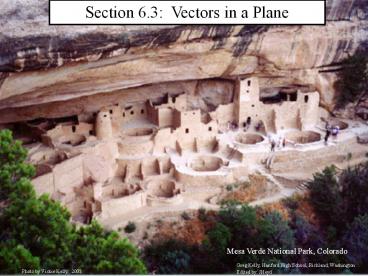Calculus 10.2 - PowerPoint PPT Presentation
Title:
Calculus 10.2
Description:
Title: Calculus 10.2 Subject: Vectors in the Plane Author: Gregory Kelly Last modified by: kcuer Created Date: 3/20/2002 7:03:20 PM Document presentation format – PowerPoint PPT presentation
Number of Views:176
Avg rating:3.0/5.0
Title: Calculus 10.2
1
Section 6.3 Vectors in a Plane
Mesa Verde National Park, Colorado
Greg Kelly, Hanford High School, Richland,
Washington
Photo by Vickie Kelly, 2003
Edited by JHeyd
2
Quantities that we measure that have magnitude
but not direction are called scalars.
Quantities such as force, displacement or
velocity that have direction as well as magnitude
are represented by directed line segments.
B
terminal point
The length is
A
initial point
3
B
terminal point
A
initial point
A vector is represented by a directed line
segment.
Vectors are equal if they have the same length
and direction (same slope).
4
y
A vector is in standard position if the initial
point is at the origin.
x
The component form of this vector is
5
y
A vector is in standard position if the initial
point is at the origin.
x
The component form of this vector is
The magnitude (length) of
is
6
The component form of
(-3,4)
P
is
(-5,2)
Q
v
(-2,-2)
7
Then v is a unit vector.
If
is the zero vector and has no direction.
8
Vector Operations
(Add the components.)
(Subtract the components.)
9
Vector Operations
Scalar Multiplication
Negative (opposite)
10
Sum of Two Vectors
u
v
u v is the resultant vector.
uv
(Parallelogram law of addition)
v
u
11
Difference of Two Vectors
v
u v
u
u v
v
12
Unit Vectors
Note that u a scalar multiple of v. The vector u
is called a unit vector in the direction of v.
13
The unit vectors and are
called standard unit vectors and are denoted by
and . These vectors can be
used to represent any vector as follows
The scalars are called the horizontal and
vertical components of v. The vector sumis
called a linear combination of the vectors I and
j.
14
Any vector can be written as a
linear combination of two standard unit vectors.
The vector v is a linear combination of the
vectors i and j.
The scalar a is the horizontal component of v and
the scalar b is the vertical component of v.































